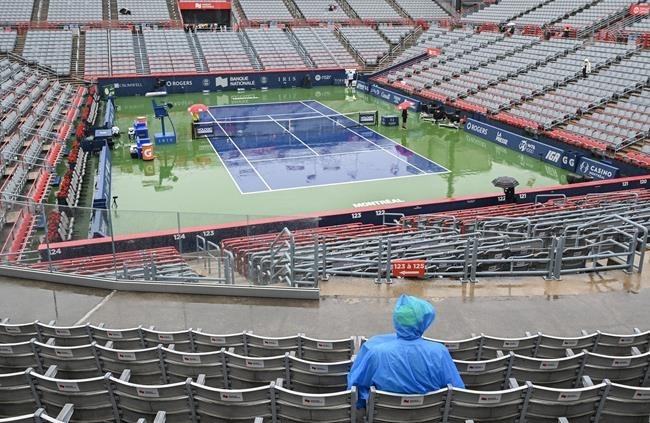MONTREAL — For the first time in 21 years, Eugene Lapierre took in the National Bank Open in Montreal from the sidelines.
The longtime tournament director wasn’t envious of the scheduling headache his successor, Valerie Tetreault, faced last week as rainy weather affected nearly every day of the tournament.
"I was kind of relaxed but I was feeling for my team,” Lapierre, who remains a consultant with Tennis Canada, told The 91Ô´´ Press on Monday. “It was a very terrible first week of events for my successor, but I think they handled everything as best as we could in the circumstances.”
Because of the weather, Liudmila Samsonova of Russia was forced to play twice on Sunday, looking noticeably fatigued in the second match — a 6-1, 6-0 women’s singles final loss to well-rested American Jessica Pegula that lasted a mere 49 minutes.
Samsonova's semifinal was originally scheduled for Saturday evening but got pushed to Sunday, while Pegula managed to beat the rain by playing in the first semifinal Saturday afternoon.
The Russian had just over two hours between her one-hour 43-minute win against Elena Rybakina of Kazakhstan, which began around 1:30 p.m., and the 5:30 p.m. final.
After the loss, Samsonova said she would have liked more time between matches, “but they said it’s not possible.”
Samsonova had already played twice on Friday and believed the organizers should have found a way to avoid having her play twice in one day again.
The National Bank Open has pushed finals to Monday due to weather before. Lapierre remembers the 2010 tournament, where “we didn’t hit one single ball between Saturday and Sunday” and both the semis and the finals had to take place Monday.
This Sunday, however, the weather co-operated. For that reason, Lapierre doesn’t believe moving the final would have been a consideration.
“I think when we can play, we play. That's the same everywhere, in all tournaments. You're not going to not play if it's sunny and nice outside,” he said. “We've had people play two matches in the same day numerous times in the past.Â
"It just happened that (Samsonova) thought it was pretty difficult. She had a very difficult opponent in front of her."
Lapierre says he didn’t take part in the discussion on the  timing of Sunday's matches, but he points out that late afternoon and early evening are the best times for fans and television.
"We consult everybody when these things happen, we talk to the players first, we talk to the WTA, we talk to television, and we know what the fans like and want,” said Lapierre. “It's a show, so we have to take everything into consideration and I think with the same situation, 100 times out of 100 times we'll make the same decisions.
"If the players agree prior, and the WTA is on top, and the supervisor, and all the organization, then that goes."
Rybakina faced an arduous schedule of her own. She and Daria Kasatkina of Russia played the last match on a jam-packed Friday with extra matches after bad weather Thursday.
The match didn’t start until 11:26 p.m. and ended up being a three-hour 27-minute marathon that wrapped up close to 3 a.m.
Rybakina won, but said Sunday after her semifinal loss that she felt “destroyed” and blamed the WTA for the scheduling. Rybakina also said “we could avoid the situation easily,” but didn’t say how.
The tournament scheduled five matches on centre court that day with play starting around noon.Â
Lapierre says it’s hard to attract fans any earlier, and adds that it normally would have left ample amount of time to complete all the matches at a reasonable hour. It just so happened that they went so long — with four of the five going three sets.
"I can guarantee you any tournament in the world would have done just exactly the same,” he said. “With five matches starting at 12, it's good. It's never too much. It just happened that it was unbelievably long matches."
Despite the weather and unpredictable schedule, Tetreault, working her first tournament as director, announced Sunday an estimated attendance of 215,000 fans — eclipsing the previous high of 182,000 in 2014.
Tetreault says the conversations about a roof at IGA Stadium went far before the pandemic, but priorities changed after finances took a hit when the 2020 tournament was cancelled.
Lapierre also said last Monday he didn’t believe getting a roof was urgent because they’d negotiated a 30-year agreement between the ATP, WTA and City of Montreal in 2022, ensuring the long-term viability of the tournament.
But when it rains like it did last week, the roof has returned to being a focus for Tetreault.
She says that although it’s not mandatory for tournaments, that could change, and Tennis Canada shouldn’t wait until it reaches that point before reacting.
“Of course, the Grand Slams have roofs, but even in the 1000 tournaments many of them have a roof. So this is pressure on our tournament,” she said. "It's not mandatory yet to have a roof, but it can become mandatory in five years or in 10 years.Â
“If we wait until then, it will be a bit too late to talk about it.”
This report by The 91Ô´´ Press was first published Aug. 14, 2023.
Daniel Rainbird, The 91Ô´´ Press



